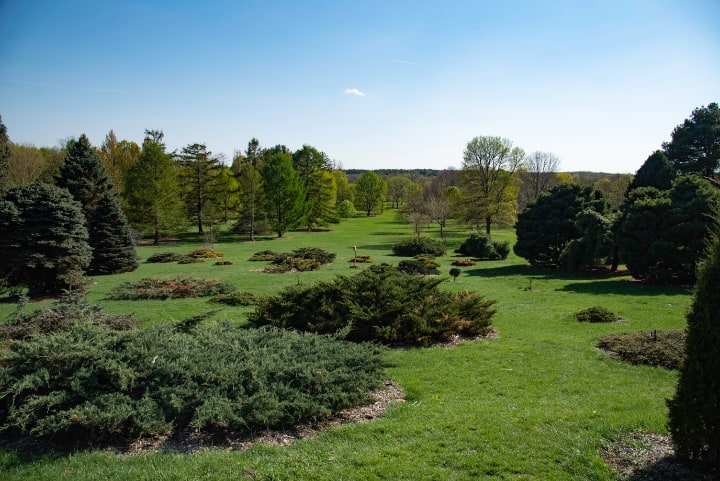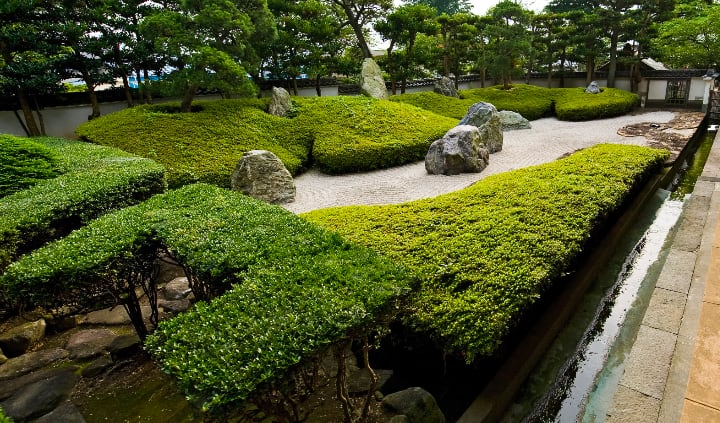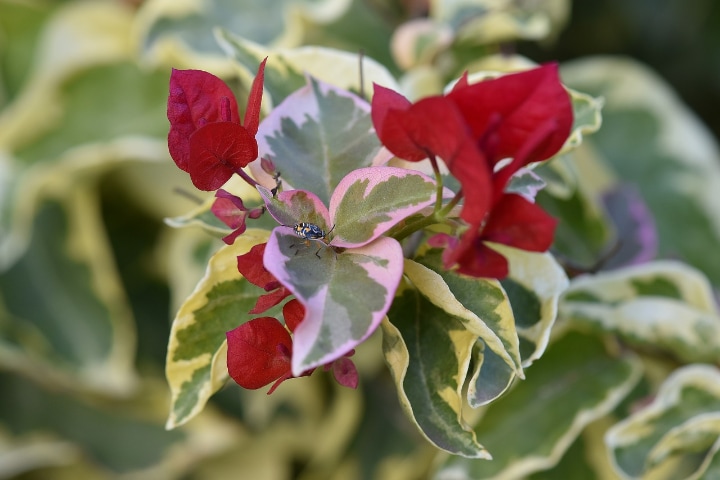How about you biannually aerate your acidic or alkaline organic vermicomposted soil with anaerobic organisms to amend and improve the germination of seeds instead of pruning or deadheading those perennials so that pollination happens naturally?
Yes, that is an actual sentence in way too complicated gardening terminology that too many gardeners love to use. But fear no more, at Planted Well we use easy to understand gardening terms in a simple and effective garden and plant glossary.
The Complete Gardening Terminology Index
Below you will find our ultimate gardening term list with all the ins and outs of gardening explained in lay-mans terms, to prepare you for your next harvest.
Anything missing? Feel free to email me with your garden term and I’ll add it immediately!
Abreuvoir
A watering trough, fountain, or structure originally intended to provide humans and animals at a place with fresh drinking water. Nowadays it’s typically found in gardens as a water feature or ornament.

Acidic Soil
A soil (or compost or liquid) with a pH between 0 and 7.0 (on a scale of 0.0-14.0). The pH is a measure of the amount of lime (calcium) contained in your soil and acidic soil is often referred to as “sour” soil by gardeners.
Acre
A measure of land totaling 43,560 square feet (or 4046 square meters). A square acre is 208.75 feet (or 63.6 meters) on each side.
Adonis Garden
According to Ancient Greeks, an Adonis garden is a place haven full of herbal plants.
Adventitious
Root growth occurring from any point other than the root as from a stem or a leaf.
Aerate
Loosening, puncturing, or punching holes to a compacted soil to allow air, water, and nutrients to reach the plant roots better. While tilling is one of the traditional ways to do this, you can now use an aerator for minimal disturbance.
Aeration
The amount of space in the soil where air can water can pass. These air spaces serve as an effective passage for beneficial worms and insects. Sandy type of soils offer the greatest aeration while clay soils offer the least amount of aeration. Root crops such as sweet potatoes and carrots particularly love well-aerated sandy soil for their lightness.
Aerial Root
Roots that develop above the surface such as with orchids that take water directly from the air.
Aerobic
Describes organisms living or occurring only when oxygen is present.
Aeroponics
A plant growing method where the plant roots are not on the ground. Instead, its roots are suspended in air and are receiving nutrients through a constant mist in the system.

Agamospermy
An asexual reproduction of seeds that only need one gendered sexual organ
Aggregate culture
A method that uses solid materials such as gravel, sand, and rock wool to grow plants.
Agriculture
The practice of farming which involve land cultivation, growing of fruits and vegetables, and rearing animals.
Air layering
A propagation method where you partially cut a branch or tree and wrap it with moist medium to stimulate and form new roots. This method is usually practiced in bonsai cultivation.
Alkaline
A soil with a pH between 7.0 and 14 (on a scale of 0.0-14.0). Often referred to as “sweet” soil by gardeners.
Amending
This means to repair your soil quality by adding in compost, manure, or another natural fertilizer.
Anaerobic
Describes organisms living or occurring where there is no oxygen.
Annual Plants
An annual plant is one that completes the life cycle in one season. They must be planted each year from seed and will die at the end of the season.
Arbor
A garden structure with latticework intended to support climbing plants and vines. It is often shaped like a tunnel.
Arboretum
A garden with a large collection of trees and shrubs cultivated for scientific or educational purposes.

Asexual propagation
The process of using the body tissue of a parent plant to generate a new plant that is identical to one parent
Auxin
Auxin is a type of hormone or substance responsible for controlling the development and growth of plants, despite its relatively simple chemical structure. Auxin controls cell division, cell expansion, and cell differentiation and is also responsible for cell elongation in plant shoots.
Baby Greens
Young herbs and leafy vegetables that people harvest at just two to four inches tall.
Barefoot
Plants, trees, shrubs, and vines sold while in a dormant state, usually available from late winter to early spring. Without soil or pot along with them, they are sold with their roots exposed so they are immediately ready for planting. These plants have grown in the field prior to being sold to new plant owners.
Bedding Plant
Plants (mainly annuals) that are set in a flower bed for decorative purposes. They have typically nursery grown to blooming size. Then, transferred to a flower bed to serve as a quick seasonal display of stunningly vibrant foliage and flowers.
Biannual Plants
Important for seed savers. A biannual is a plant whose life cycle is completed in two seasons (can be harvested in the first year). Carrots and most root crops, like the potato plant, are examples of biannual plants.
Biennial
A plant that lives for two years; grows in the first (produces stems and leaves), then, reproduces (makes flowers and seeds) and dies in the second. Parsley and onions are biennial plants, especially if grown from seeds.
Cold Frame
An unheated four-sided frame made of wood or other materials and covered with either a hinged clear plastic sheet or glass. The structure perfectly encloses plants while holding the sun’s heat in spring or fall, making it a perfect shelter from the harsh cold temperatures changes. It is essentially a mini greenhouse that fits in a single planting bed with the sole purpose of extending the life of hardy and half-hardy plants outside their usual growing season.
Compost
Dubbed as “Black Gold, compost is a soft dark odorless organic matter that is a product of completely decomposing and breaking down plant materials like leaves and vegetable scraps. With its richness in nutrients, it is perfect in fertilizing and conditioning soil. Adding it to clay soil increases its draining abilities and mixing it with sandy soil increases water retention.

Conifer
A perfect source for soft wood and turpentines, Conifers are evergreen and fast-growing woody trees that produce cones and needle like leaves.
Deadheading
The removal of dead flower heads in a plant through pinching, cutting, or snipping to promote and extend bloom period while improving appearance preventing self-seeding or bolting.
Deciduous
A plant or tree that sheds it leaves or foliage every year, typically during the fall or winter months.
Dormancy
The yearly state of plants at which its activities are reduced so it can survive low temperatures (winter or fall), drought, and sometimes stress. During this period, it does not grow nor flower. Be sure not to fertilize your plant when it is dormant.
Erosion
The gradual wearing away, washing away, destruction, or removal of soil due to the weather, wind, water, or human activities.
Espalier
A fruit tree or shrub that has been trained to grow flat on a surface (either a wall or a lattice), mainly to effectively support it once it bears fruits. To achieve a flat look, the tree’s stems and branches are trimmed, pinched, or tied.
Evergreen
Plants that never losses their foliage, therefore, keeps its green colors all year. Evergreen plants are also typically functional and useful for more than one growing season.
Fertilizer
It can be liquid or granular material and organic or synthetic but it is always packed with essential plant nutrients. They often contain nitrogen, phosphorus, and potassium. Fertilizers are used to amend to the soil to increase its quality and fertility for higher quantities of healthy plant growth.
Floating Row Cover
A sheer lightweight polypropylene fabric used to cover plants without depriving them of their needs as it still allows air, sun, and moisture to pass through. Gardeners use them to trap heat in spring or fall, shade plants in the summer, fend off pests and animals in spring, and extend the growing season in winter. You can either place it directly over plants or over structures to support it. These also come in different thicknesses, depending on the season.
Furrow
A small shallow trench gardeners make on the soil so they can plant seeds, seedlings, and bulbs. It can also be the depression between raised plant beds.

Germinate
The end of seed dormancy and the beginning of its growth. When the seed starts to shoot, sprout, or bud above the soil, it means that the embryo on the seed is transforming into a seedling (a leafy young plant).
Grafting
A propagation method where a scion (a shoot or bud with a preferable flowering or fruiting trait) is artificially inserted into or joined to a rootstock (a stem, branch, or root of different but related plant with a better root characteristic) so that they will fuse as one and become a hardier plant (plant that is more disease resistant).
Ground Cover
Low-growing effective-spreading plant that used to cover large or empty bare-earth areas to add aesthetics, create uniform appearance, and protect the soil from erosion or drought.
Heirloom
A highly-valued non-hybrid open-pollinated plant that is at least fifty years old which has been passed down through different generations for its favorable characteristics (flavor or color). Some heirlooms are Arkansas Traveler, Cherokee Purple, Bradley, Homestead, and Rutgers.
Herbaceous
Non-woody perennial plants with soft green leaves and stalks that becomes dormant in winter through underground rootstocks and resumes in spring.
Humus
The end product of composting, humus is a loamy organic matter that contains nutrient-dense molecules from decayed leaves and other plant material produced by soil microorganisms and microbes. Humus helps improve the structure of soil and makes enhances moisture retention.
Indeterminate
Describes varieties of tomatoes that grow and bears fruits all seasons, except the first frost of fall. Sometimes these varieties are also called pole tomatoes or vine tomatoes because their fruits grow on the lengthy vine.
With such long vines, they need trellises built for them to crawl into for support. Some samples of indeterminate tomatoes are Super Sweet 100, Big Boy, and Early Girl.
Inflorescence
The complete structure of the flower head that holds the flower of a plant. These include stalks, stems, bracts, and the flower itself.
Inoculant
A substance that contains Rhizobium bacteria (a beneficial soil microbe), commercial inoculants help improve soil fertility and accelerate the rate of decomposition in composts.
Inoculants come in powdered form which is added to the soil during planting. When added to peas, beans, and other legume crops, it can directly improve the yield of beans you can harvest.
June-Bearing
In contrast to ever-bearing plants, specifically strawberries, June-Bearing is a word used to describe strawberries that only bear fruits once in June or any day in the mid of the season.
Karesansui
Perfect for spending time while on a peaceful trance, Karesansui is a small but well-maintained zen garden.

Kelp Meal
A natural source of potassium and micronutrients, Kelp meal is a soil amendment that is made from dried and ground kelp seaweed.
Knot Garden
A garden with plants that are arranged in a knot formation, usually similar to Celtic knot signs.
Lime
A kind of soil amendment made of calcium carbonate that effectively raises soil pH and reduces acidity. It comes in pelletized and powdered form which can be fast-acting or month-long acting depending on your plant’s preferences.
Be sure to read labels to know what applies to you. Nevertheless, lime is perfect for growing brassicas like broccoli and cabbages. This calcium compound also helps prevent cub root disease.
Loam
A highly fertile soil ideal for growing with the perfect balance of sand, clay, and silt that is abundant of humus and organic matter.
Manure
Organic waste from animals that make an effective soil fertilizer and amendment for nutrient-filled materials. There is also such a thing as green manures which are essentially cover crops that are gardeners and farmers till into the soil.
Native Plant
A plant the naturally occurs and grows in a certain location or region.
Naturalize
The process of planting randomly. Without following a pattern, it creates the effect of how plants grow in the wild, without man’s help, so that the plants grow healthily even if it is away from its natural habitat.
Nitrogen
An element that plants use in large quantities to fuel their growth, therefore, it is always included in fertilizers.
Ornamental
Beautiful plants that are grown for their aesthetics and not for consumption.
Panicle
Loose airy clusters flowers or crops with multiple branches. A great example of a panicle is oats.

Peat Moss
Typically used in potting soil, peat moss is a mixture of the decomposed remains of various mosses and vegetation that is known for its excellent water-retentive qualities, spongy looks, and its ph-lowering traits. It is perfect for acid-loving plants!
Rhizome
A modified type of plant that grows its thick fleshy stems or runners horizontally under the soil surface, from which, new stems, roots, and shoots sprout. Examples of rhizomes are irises and lawn grasses. With such qualities, rhizome plants can easily colonize large areas making them invasive to some.
Rootstock
In grafting, it is the part of the plant the grows underground which mainly contains the roots, that preferably have desirable root system traits and quality. They usually impact the plant’s height and promote a dwarfing habit.
Seedlings
A baby plant that has grown leaves from a seed.
Shrub
A woody perennial plant, either deciduous or evergreen, with several woody stems and trunks that is smaller than a tree, especially if properly pruned.
Tap Root
One primary root that grows vertically straight into the ground, from which, smaller roots sprout from. Note that not all plants have a tap root.
Tender Plants
In contrast to hardy plants, tender plants are highly vulnerable plants when it comes to certain temperatures. They cannot survive freezing temperatures or frost.
Tendril
A slender part of a plant that twirls into ringlets which allow plant vines to attach itself to structures like trellises, fences, walls to better support its growing body.
Umbel
A flowering plant with a flat-topped dome-like cluster of flower heads with short stalks of similar length that radiate from a single common point. It looks similar to the ribs of an umbrella. Geraniums, Dill, and Queen Anne’s Lace flowers are beautiful examples of umbels.
Underplanting
The process of filling the space around a tall plant like a tree with a small plant that need minimal space.
Variegated
Plants with multicolored foliage. Its leaves feature patches, edges, or stripes that are different from the main leaf colors.

Weed
Unwanted plants who chose to rampantly grow in the wrong place where your plants are located and are continuously competing against your plants’ water, light, and food. Get rid of them!
Wheelbarrow
A helpful container with wheels that makes it easier to move things (big or small) around the garden.
Worm Casting
The most nutrient-dense organic compost you can find, these are organic excrements of red earthworms from what they ate and digested, which undoubtedly makes soil more fertile.
Xeriscaping
To design a low-maintenance landscape using native plants and drought-tolerant plants like succulents and cacti. With these, not only is the water consumption reduced, but the need to set up expensive irrigation systems are also instantly out of the equation.
Xerophyte
Types of plants the still thrive in regions with limited water sources because it only needs little water to survive. A great example is cacti.
Yew
A type of coniferous tree that bears red berry-like fruits which you should never eat as most parts of it are poisonous.

Yield
Mainly a term used to describe crop production. Sometimes it also refers to the crops we eat.
Zone
Referring to the Growth Hardiness Zone where temperature ranges make it easier to determine which types of plants can grow in an area. Usually, there is a map on the back of seed packs that shows which zones the plant can grow and when to grow them.
Can’t find the Gardening term you are looking for?
Don’t worry, we will continuously update this comprehensive list for you weekly. Just email me what you are looking for so we can add it to our queue and publish it in no time.
By doing this, you and I will be able to help our fellow gardeners understand more gardening terms in the future! Or…just leave a comment below!

Leave a Reply